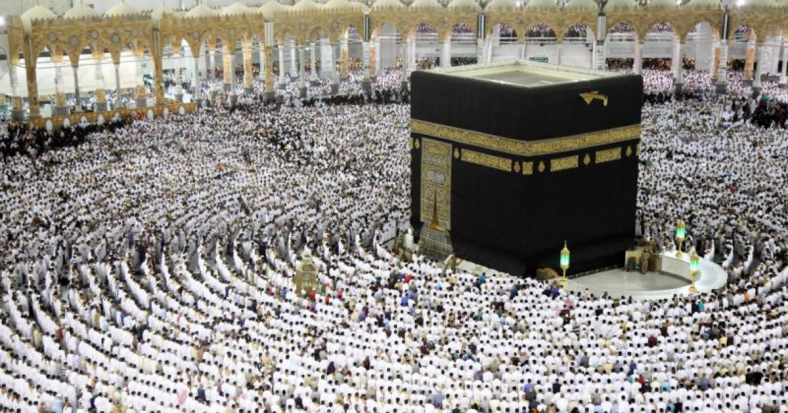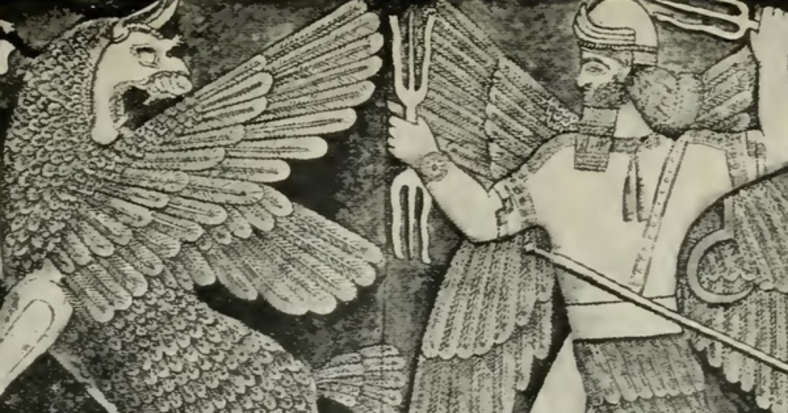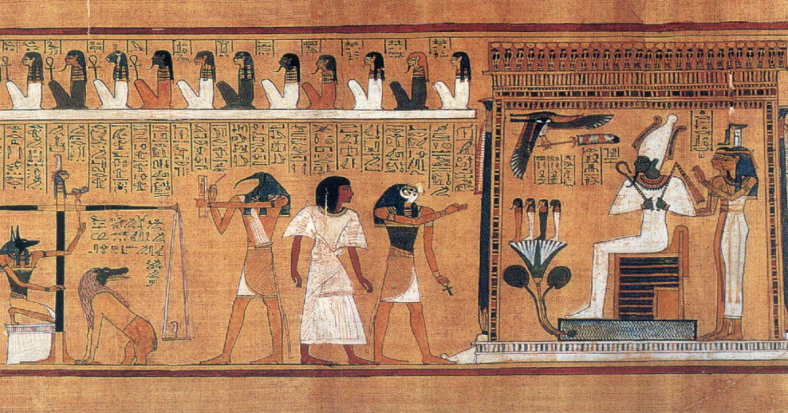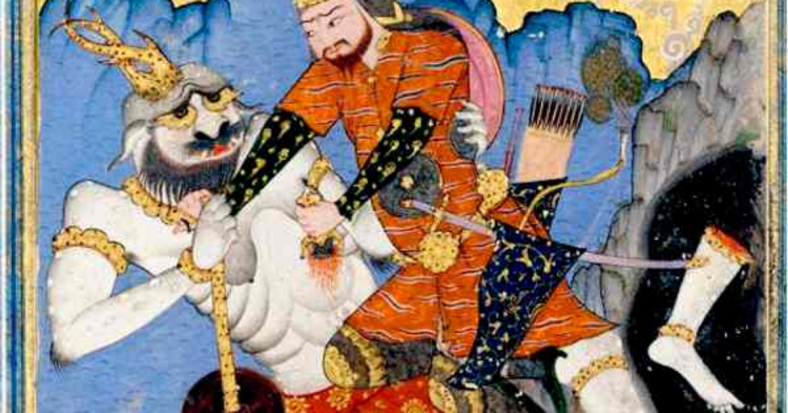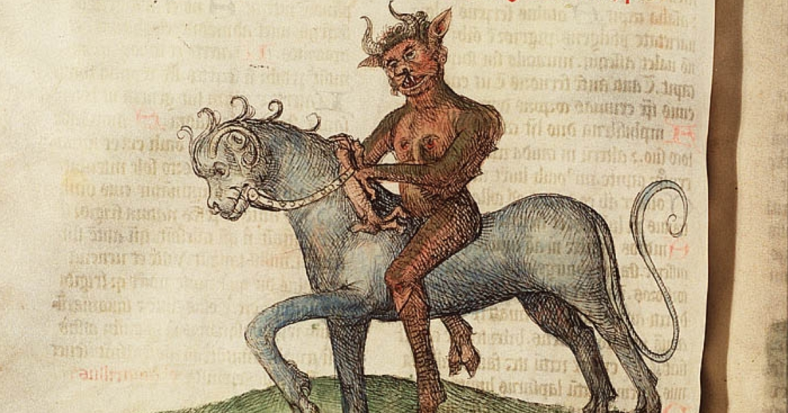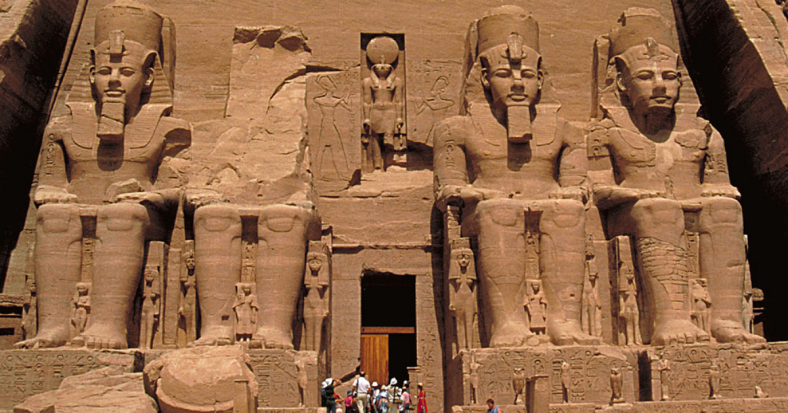This Week’s Prompt:82. Power of wizard to influence dreams of others.
The Resulting Story: The Magi and King Morgan Part 1
Dreams and magic are large and recurring themes in a number of these prompts. And so today we’ll take some time to not only discuss the folklore of dreams and magicians—of which there is plenty—but some of their fascination, particularly in the time of Lovecraft, and some occult theories (however medieval). Needless to say, the man who commands dreams is to be feared in deed.
Recent works of fiction have put strains to separate the wizard from his various compatriots—the witch, the sorcerer, the warlock, the shaman, the priest, the magi. At its root, the word wizard does derive from the word “wise” and refers to the learned man or the sage. However, as we have documented, this does not mean a man who is benevolent nor does it mean one who does not make pacts with dark powers, nor one who does deal in holy powers. While witchcraft in an anthropological sense is associated with unintended malicious power, wizadry and sorcery tend to be more prepared. In a folklore sense, however, we would do well to remember that the line between the cunning folk and the wisemen is not always clear. So, what can wizards do?
In Scotland, we have many records of the powers that a witch or wizard might exert over the world. Powers over wind and weather, storms called up and sent back down are reported among court documents. In both Scotland and Nova Scotia, this power extends to strange orbs of fire in the night—often that burden the body and the mind. The same text reports tales of darkness conjured by sages of India in Marco Polo’s narratives. Scottish sorcerers also exerted the ability to render things sterile or fertile.
Scottish and other English wizards were also ascribed the power of commanding animals and humans alike, as we have discussed when talking of the devil’s deals. These powers could result in death or worse, trapping people until the starved. Particularly skilled practitioners as late as the 1800s (and to this day in some places) have the power to bewitch serpents and endure their bite without harm.

Nova Scotia folklore reports a way of gaining power over a person with a ritual. One must find a frog, tie his legs to avoid him hopping, and put him atop an ants nest. In time, the ants will devour him, and the frog will begin hollering and yelling. You must not hear him holler—that will kill you. After nothing but ones are left, take the hopping bone—his hind leg. Place it on your target’s body for a few seconds, and they will be yours. This same rite yields different variations, sometimes using serpents for the purpose or using two bones. The first bone ensnares the second bone sends the person away.
Fiji and other places have reports of magic that follow a broad theme of requiring a portion of the victim to be of any use. This rule can be illustrated in a dispute between two men, Fillipi and Nayau. The two men, after arguing over who was the superior magician, exchanged food. The sorcerers set about certain secret workings on these objects, and then place them in the roof of their victim. These workings include fasting, eternal heat for four days, and aversion to the sea. Fillipi ends up dead—however, Nayau fails to find his body and release the evil Fillipi had built up. The Nayau man thus also falls dead, his spear stabbed into the incorrect grave on the last night. Proper treatment of the dead having unexpected consequences might be the topic of this weeks patreon or another time—needless to say cosmic events have sometimes emerged from reckless ignorance of cosmic forces.
Tibetan magic intending to harm someone is equally attested to. Placing hair or nail clippings under the altar of a wrathful deity, for instance, draws the destructive power towards the target. Cursing and invocation of these powers is alos a means of harm. More elaborate, however, is the ngan gdad. This ritual requires nail or hair clippings, placed in a circle. The cirlce is marked by four curses—each reaffirming that something must come to an end (the life, the descent, the heart, the body, the power)–which is smeared with menstral blood along with the clippings. The entire ritual is placed on a prepared paper with an image of the person, and wrapped in a package. The package in turn is placed in a yak’s right horn, with additional harmful items—the blood of a man, a woman, and a dog; brass and iron filings from a smith; earth from a cross road; and an object used in a suicide; a portion of a woman who died in birth; some acontine; and water from an underground spring. This concoction is topped off with two live spiders, who are sealed inside with the hair of a corpse. This is sealed with poisonous wood.
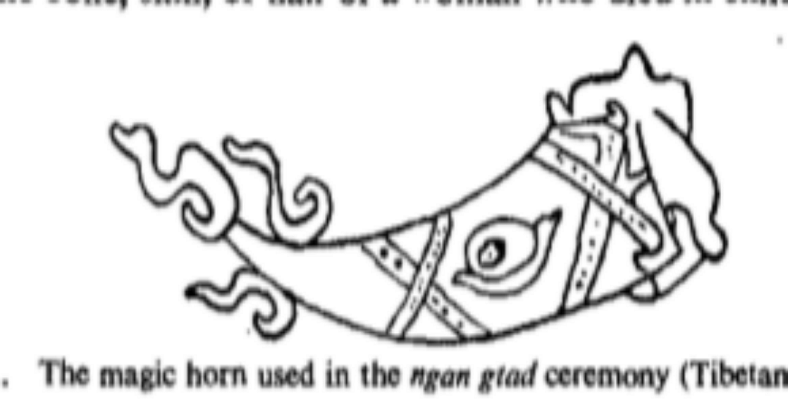
The entire process is poisonous, so the sorcerer must avoid his own contact. After this, a ritual involving the bones of the poor, the butchered of war, and earth of a haunted mountain is preformed. The wrathful gods are invoked, and the magician will attempt to hide the horn in the victims house during dawn or sunset. Within three months, the first signs of misfortune appear. Eventually, the entire family of the house dies.
While this is the most elaborate Tibetan ritual, it is not the only means recorded for tibetan sorcerers to work harmful magic. A number of lesser rites are codified that invovle drawing a mandala of a specific color and working with a statue or image of a person. Others involve the writing out of names and descent to invoke illness and malady, and elaborate rituals like the above to call upon four armed killers. For sake of space, we will abridge those specific rituals.
Interpretations of dreams in Tibet, as elsewhere, is seen is a way of understanding the future. Among most persons, dreams of being clad in armor, riding a miraculous steed, or being in formal dress are all good signs of progress and prosperity. However, dreams of storms, swamps, and filth are ill omens. Different spirits can also influence dreams—a theme we will follow through out our work, as the wizard often works through spirits and other such things. “One can also determine which class of spirits caused the hallucinations one experienced in a dream: if one saw a snowy mountain or a soaring white bird, then the lha caused this dream. When seeing an old temple, images of clay, a fox, or a small child, the dream was caused by the ‘gong po demons. To see snakes, frogs, girls with a·pale-blue skin, and mountain-meadows are mirages caused by the klu. The btsan make one see rocks, trees, riders, and warriors, the the’u rang let appear ash-coloured children in one’s dreams; if one sees the figures of Buddhist priests, of asses, monkeys, rats, horses, and dogs, these dreams were the work of the rgyal po demons, and if one trembles with terror and fear in the sleep, this is due to the influence of the bdud.”

Dream interpretation is also marked by Cornelius Agrippa, a famed occult writer in the middle ages. Agrippa attests to beliefs that dreams are celestial influences—drawing the common distinction between fantasy and true dream. While dreams are according to Agrippa effacious, he regrards them as unreliable. Or, rather, omens that cannot be universally understood with one meaning. Nonetheless he argues for a focus on the potential and influence of dreams on this world, and if understood accurately is the most effective means of seeing the future.
Dreams as divine messengers are of course common. We have Daniel, a wise man who’s position is derived from his ability to understand dreams (and who, perhaps like a sorcerer, has no fear of animals). We have the Odyssey’s dream messages from Athena. We also have, notably, the use of dreams by Juno in the Aeneid. Here, dreams are the tools of wrath and are used to misled the Etruscans into a doomed war against Aeneas.
The use of dreams to see faraway places is promient in later works. We can consider, for instance, the story of visiting the Antartic that is found in . Here the narrator bears witness to a great battle among old gods—Zeus and Odin set about a war path, as their lands are being pushed ever farther back. A tale by the same author in In The Pale of a similar man, who went to the Antarctic and found the lost tribes of Israel and the descendants of Moses living there as if in a new Eden.
The wizards power over dreams, however, takes the most direct appearance with the Night hag and other commanded spirits. We discussed the Night Hag at length here, but there is of course more to say then that. We can consider the creatures a Sumerian exorcist encountered, which included the invisible demon Alu. The alu dwell in ruins, and wait to rush upon people at night, enveloping them in their garments or sneaking into bed rooms to steal men’s sleep. They appear as half-man half-demon creatures, sometimes faceless, earless, or even limbless. The baku of Japan is another strange dream spirit—it frequently is called upon to eat dreams, and has a generally benevolent image. That said, a hungry baku may devour good dreams as well—destroying hopes in the process. The Baku has gained a more benevolent reputation as of late, however, as it eats nightmares of children. Also, it looks more snuggly then a demon lurking on your bed.

Western powers over dreams are also ascribed. The Book of the Magus suggests a method by which a wizard may compel or bring forth true dreams. It relies on the construction of a ring dedicated to celestial powers, prepared at a key moment in time. The subject of the dream is to be tied to the power and moment—as is normal for the creation of such talismans in Western occultism. The practioner must also fast and obstain from many worldly pleasures in order to avoid ruining his project.
The Magus reports an incident where dreams give the impression of soaring and flying, in a way comparable to our earlier examples from weird fiction:
“At LINTZ I worked with a young woman, who one evening invited me to go with her, assuring me that without any risk she would conduct me to a place where I greatly desired to find myself. I allowed myself to be persuaded by her promises. She then gave unto me an unguent, with which I rubbed the principal pulses of my feet and hands; the which she did also; and at first it appeared to me that I was flying in the air in the place which I wished, and which I had in no way mentioned to her.
Pass over in silence and out of respect, that which I saw, which was admirable, and appearing to myself to have remained there a long while, I felt as if I were just awakening from a profound sleep, and I had great pain in my head and deep melancholy. I turned round and saw that she was seated at my side. She began to recount to me what she had seen, but that which I had seen was entirely different. I was, however, much astonished, because it appeared to me as if I had been really and corporeally in the place, and there in reality to have seen that which had happened. However, I asked her one day to go alone to that same place, and to bring me back news of a friend whom I knew for certain was distant 200 leagues. She promised to do so in the space of an hour. She rubbed herself with the same unguent, and I was very expectant to see her fly away; but she fell to the ground and remained there about three hours as if she were dead, so that I began to think that she really was dead. At last she began to stir like a person who is waking, then she rose to an upright position, and with much pleasure began to give me the account of her expedition, saying that she had been in the place where my friend was, and all that he was doing; the which was entirely contrary to his profession. Whence I concluded that what she had just told me was a simple dream, and that this unguent was a causer of a phantastic sleep; whereon she confessed to me that this unguent had been given to her by the Devil.”
In Mongolia the framing device of the Saga of the Wise Walking Khan involves the son of a khan enraging a group of magicians. These seven magician brothers are first approached by the two brothers, to learn the art of magic. They teach the elder brother false lessons, while the younger brother at night listens at night to learn the true lessons. Afterwards, the younger brother comes up with a scheme. He tells his elder brother that there will be a new horse in the stables asks his brother to take it to be sold—but not to walk past the seven magic brothers. The elder brother does not believe there is anything to fear from the magicians—after all, they didn’t teach any magic so they had no power. The Seven Brothers recognize the magical horse and worried their monopoly will be broken, descend with intent to kill the horse, after buying it.
The horse, it happens, is the younger brother in disguise. His intent was to turn into a horse, be sold, turn back, and flee.
After a shapeshifting chase, the younger brother finds his way to a great sage. He asks the sage to turn him into a bead and hold him in his mouth—and to turn seven beads into worms, as the magicians approach the door as mere men. The magicians see the worms, and thinking one is the younger brother, they turn into birds to devour them. The great sage drops the bead, and the younger brother emerges. He takes a great stick and kills them all. His saga then follows his tasks to repay the great sage.
The Greeks marked this division of dreams between fantasies and reality with the twin gates in the realm of Hades. There, dreams of falsehood flow from the gate of ivory, and dreams of truth from the gate of horn. Dreams are also there tied into the lands of the dead. The power of the dead to talk in dreams is attested to, almost as thoroughly as the power of the cunning wizard to speak with and command the spirits of the dead. But that will have to wait for another time.

Around the time of this prompt, it was not only the occult world that had interest in the world of dreams. Rather, the scientific community—or the begins of one—showed interest. We can consider the work of Sigimund Freud, who suggested dreams showed supressed and buried desires and ills. Carl Jung, one of his disciples, expanded this notion of the power of dreams to communicate from the great unknown of the unconcious mind. Jung extrapolated the source of these dreams into a vast universal unconcious, where the whole of mankind might be said to be dreaming.
The notion of dreams that are more substantive then reality, and the potential for sages to influence them, calls to mind an old Taoist story. Once Chuang Tzu said that he was dreaming he was a butterfly—and only knew his happiness as a butterfly. The sage wondered, was he a butterfly still dreaming he was a man or a man dreaming he was a butterfly? The sage leaves the question unanswered.
In dreams a man can live a thousand lives, wear a thousand different faces. The power of dreams then is two fold—to make a life like illusion, and to send messages of great importance. It isn’t hard to see how a wizard with command over dreams might manipulate a community—even barely remembered, dreams of the same thing over and over are effective. If we grant our sorcerer can observer the sleeping persons, then we have new elements to introduce. A sorcerer might use these gazes to test his victims, as a sort of fantastic simulation. As we have seen here, the danger of a wizard is great especially if personally invoked. We had a wizard hero last story, so I think this time we will have one in a villainous role.
I am also feeling a bit more fantastic. That is, away from set in stone locations ot an unknown place. Given the Sumerian story, I think the lair of this wizard is the crumbling ruins of some old temple or palace—and perhaps there is where whatever ritual or tools he uses are found. What sorts of magic might he work? What plans does this wizard have? There is horror to be found in a man who from afar exerts power over the elements, the invisible killer. The dread master with his assistant spirits.
If you’d like to support the Society, receive more stories or research, or are feeling generous, please check out our Patreon here.
Bibliography
Nebesky-Wojkowitz, Rene. Oracles and Demons of Tibet. Kathmandu, Nepal, Book Faith India, 1993.
Dalyell, John Graham. The Darker Superstitions of Scotland.Glasgow, R.Grifin.co, 1875.
Busk, Rachael Harriet. Saga of the Far East; or Kalmouk and Mongolian traditional tales. London, Griffith and Farran, 1973.
Fauset, Arthur. Folklore of Nova Scotia. New York, American Folk-lore society, G.E. Strechet and Co. 1931.
St. Johnson, Reginald. The Lau Islands(Fiji) and their fairy tales. London. The Times book co. ltd 1918.
Iliowizi, Henry. In The Pale: stories and legends of Russian Jews. Philidelphia. Coates. 1900.
Iliowizi, Henry. The Weird Orient: Nine Mystic Tales. Philidelphia. Coates. 1900.
Thompson, R. Campbell. The Devils and Evil Spirits of Babylonia. London. Luzac and co. 1903-1904.











